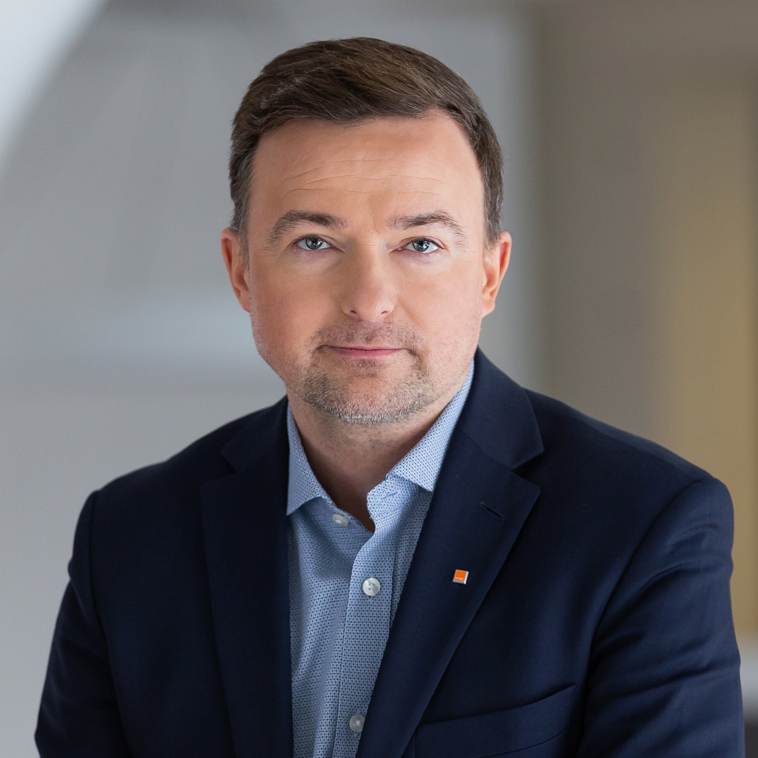Q: You delivered on all your financial commitments in 2019. What would you highlight as particularly important in the financial results of last year?
We are very consistent when executing our strategy and this is driving our performance. In 2019 our operating profitability improved for the second consecutive year; however please note that this growth was of a better quality than in the previous year. Let me explain what I mean by that. Gain on asset disposals reached a record high in 2019. The driver here was the sale of the Nowogrodzka/Barbary real estate complex located in the centre of Warsaw. However, I am especially pleased that EBITDAaL increased by as much as 4.5% year-on-year even if we exclude this factor. This was not the case in 2018. This resulted both from better revenue evolution and strong cost optimisation efforts. Revenues were boosted by value-accretive commercial actions as well as successful development of our ICT business, including the acquisition of BlueSoft.

I would also like to highlight the strong improvement in our cash generation. It was supported by growing EBITDAaL, but also by balance sheet optimisations. Firstly, we continue to transform our fixed asset base and dispose of unused real estate. We are moving capital away from real estate into our fibre network deployment, which provides much better long-term returns for the Company. In 2019 we generated a record PLN 500 million of cash from real estate disposals.
Secondly, to optimise working capital we initiated a programme of sale of selected customer receivables arising from sales of mobile handsets on instalments. It is a new concept for the Polish market and its implementation required a significant effort on our part. Receivables are sold to the bank, which transforms them into a security to sell on to its customers. The terms are favourable for us compared to the cost of debt. We will continue this programme in 2020.
Q: You continue to improve your efficiency. Could you give us some examples of initiatives contributing to this achievement? How much further do you think you could optimise your costs?
The comprehensive transformation programme that we introduced as part of our strategy continues to bring outstanding results. Where possible, we are simplifying and automating our business processes at all stages of our business model. In 2019 our indirect costs were down 7%, which means that for the past 3 years the scale of efficiency gains exceeded 20%.
Let me give you some examples of efficiencies in the customer care and network areas. In customer care, we implemented several initiatives that significantly decreased the volume of contacts with our call centres. Listening to our customers’ feedback, we made invoices simpler and clearer. Our call centre teams are supported by artificial intelligence in the form of ‘chat bot’ Max, which is able to recognize around 80 different customer intentions and answer a lot of queries automatically. As a result, the number of calls with human assistance fell by 20% last year while the number of complaints fell by 25%. In addition, we are the only operator in Poland to have introduced paperless contracts for our customers in all our shops. All these initiatives generated significant savings, at the same time as benefiting our customers; the fact that we increased customer satisfaction levels in 2019 is extremely significant. I am pleased to say that we advanced from number 3 to number 2 operator in Poland in terms of Net Promoter Score. Moreover, the absolute level of our NPS was the highest ever.
In the network area, we implemented several initiatives to optimise workflow for the technical teams who install services or fix network problems. We are now able to better detect the exact location of network failures, as a result of which the number of interventions in 2019 dropped by 17%. We also constantly work to reduce our electricity consumption by investing in energy efficient solutions and using big data analytics to monitor and optimise our use of energy, among other measures. Our energy consumption in 2019 fell by another 2% despite the continued growth of data transfer in our networks.
In terms of further cost efficiencies we continue to have strong ambitions and we are constantly coming up with new ideas for simplification and automation. Savings will obviously top our agenda in 2020, especially in the light of various inflationary challenges. The new social plan we announced in December 2019 is a good example.
Q: Let’s talk a little bit about your achievements on the business market. This line of business also improved last year, didn’t it?
Services for business customers account for around a third of our total business, so improving performance in this area has significantly contributed to our results recovery. I would like to mention three factors here.
Firstly, the performance of our mobile operations improved, driven by further growth of the customer base and better performance of ARPO (average revenues per offer). Customer base growth benefitted from efficient retention actions supported by data intelligence. As a result, churn rate reached a record low. ARPO was supported by tariff increases made in November 2018.
Secondly, I would like to highlight that we are also monetising our investments in fibre on the business market. Our fibre network deployment covers not only households but also small businesses, and this customer group is growing as well. Fibre is also a key element in the transformation of our data transmission business for large enterprises, where we are gradually replacing legacy copper connections. Here we invest project by project, delivering point-to-point access for example for large retailers or financial institutions.
Last but not least, ICT operations. This line of business was given special attention in our strategy because of its growth potential and increasing synergies with our core telco operations, and it has been supported by last year’s acquisition of BlueSoft. Between 2016 and 2019 we doubled our ICT revenues, a whole year in advance of our strategic ambition.
Q: You guide for further growth of both revenues and operating performance. What are the key risks to this plan?
Our guidance for further growth of revenues and EBITDAaL in 2020 should come as no surprise. It is consistent with our strategic ambitions. The achievements of the past two years build confidence in our ability to grow. I would prefer to talk about challenges, not risks. Please note that for us the structural challenge that we have every year is the need to offset decline in high margin legacy services. Our revenues from retail fixed line telephony constitute 8% of the total, but their contribution to profits is higher and they decline by around 15% each year.
We all already know that 2020 will look very different than we expected. Coping with the impact of the COVID-19 pandemic will be an unprecedented challenge, not only for us but for the entire Polish and world economy. Today it is much too early to assess the consequences, as we do not know the severity and length of this crisis. However I believe that, relative to many other industries, Orange Polska’s business is much less vulnerable to this situation. Mobile and Fixed Broadband connectivity nowadays is critical to the needs of individuals and businesses. We derive the majority of our revenues and profits from subscription-based services, which allows us to rely on relatively stable and predictable revenue streams.
Looking at other specific factors in 2020, challenges will come from a more and more inflationary environment in the Polish economy that impacts our costs. In particular I would like to highlight energy costs and labour costs. We expect a strong increase in the cost per megawatt hour this year, as a result of last year’s price freeze (following regulatory intervention) and rising wholesale energy prices. Inflation of labour costs, driven partly by a rapid increase in the minimum wage, is impacting the cost of various external services that we buy. These challenges have obviously been factored into our plans, and they motivate us to implement more efficiency improvements to boost our capacity for growth.
Q: You decided to change the definition of your operating performance metrics again. What are the reasons?
Our business is changing so our reporting needs to reflect that. We also listen to feedback from the financial community. The key intention behind the change, which we will adopt from 2020, is to better capture the economic effects of the transformation of our fixed assets base.
Over the past few years, we have transformed rapidly from incumbent to modern integrated telecom operator. On the one hand we are heavily investing in new technologies: fibre network and mobile network. We have invested more than PLN 2.5 billion in fibre network rollout since 2016. This technology will create value for us for many years to come. In mobile, we will soon start investing in 5G technology. On the other hand we are also disinvesting. This includes disposals of unused properties mainly resulting from our legacy status, and this activity has recently strongly accelerated. Since 2016 we have sold assets with market value of around PLN 1 billion. Assets amounting to a similar value remain to be sold in the future.
Up until now, the benefits of this transformation have only been presented in operating profitability (EBITDAaL) through gain on asset disposals. However, this captured only the accounting effect. We decided to shift the presentation of these gains to capital expenditures to capture their cash impact. EBITDAaL from 2020 will include only core telecom operations, and its trend will not be impacted by somewhat volatile gains on assets disposal. This addresses the feedback we received from our investors and analysts.
Q: What are the key constraints for you in returning to dividends?
We are in regular touch with the financial community through frequent meetings and dedicated perception surveys and we are very much aware that dividends are important for investors, especially in the telecom sector. It is our intention to return to dividend payments in the future. Since the announcement of our current strategy in 2017 we have been consistent about the conditions for returning to dividend payments.
There are two key aspects here. Firstly, successful turnaround and establishing a business model that will allow us to grow on a sustainable basis: results for 2018 and 2019 confirm that we are on track. Secondly, we need to take into account the cost of acquiring spectrum. The spectrum auction for 5G is imminent and the high entry price indicates that the acquisition cost will not be negligible. In the relatively short term, we will also need to renew the licence for 2100 MHz frequency that expires at the end of 2022. There is also uncertainty regarding the allocation of 700 MHz frequency in the future. On some occasions in the past we stated that we could envisage paying a dividend in 2021 for the results of 2020. However, we cannot commit to that today. When we return to paying a dividend, our intention is that it will be based on a transparent and sustainable dividend policy.
* Maciej Nowohoński was Orange Polska CFO until 31 March 2020. From 31 March 2020 he is Management Board Member in charge of Carriers Market and Real Estate Sales. From 31 March 2020 Orange Polska CFO become Jacek Kunicki who has been for the past six years Chief Controller at Orange Polska.
